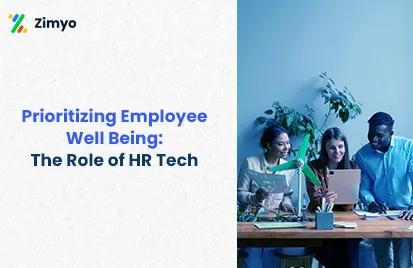In the dynamic world of the modern enterprise, the need for maximum productivity is not only a goal but also a requirement for long-term success. One of the factors in achieving the overall efficiency of any organization is working on improving employee productivity. In recent years there have been revolutionary shifts that have completely changed the way you used to work thus requiring a critical review of productivity assumptions. Have you ever wondered:
🤔 How can you redefine success within your organization?
🤔 How can you help your employees reach their full potential?
🤔 What techniques enable employees to surpass expectations rather than merely meet them?
🤔 How can you measure and accomplish productivity in your organization?
If you are looking for the answers to these questions do not worry we have got you covered. Organizations require a proactive strategy to inspire and motivate employees to put forth their best efforts.
It’s about creating a structure that ignites internal motivation, illustrates the advantages of increased productivity, and helps employees go on the path to reaching their full potential in the workplace.
So are you excited to discover the techniques that transform a typical workplace into an efficient machine?
What is Employee Productivity?
Employee productivity refers to the ability of an employee to efficiently transform requirements and instructions into output in a predetermined amount of time. This assessment requires assessing multiple factors, such as task completion time, execution accuracy, and process intervention or guidance requirements.
When you combine these evaluations and distribute them throughout the workforce, they present an overall picture of workplace productivity.
Moreover, employee productivity has a direct effect on return on investment and business outcomes.
So now the question comes how do you decide whether the productivity is high or low?
The productivity level depends upon an organization’s internal benchmarks, emphasizing the significance of individual, team, and departmental output to the predetermined criteria.
The overall success of your organization can be linked to the effective and efficient productivity of the workplace, thus making it a crucial factor in achieving the short-term and long-term goals of your organization.
Productivity is determined using a formula that weighs the output, or what is produced, to the input, which includes the number of hours worked and the resources used. In addition to an employee’s accomplishments, employee productivity is really about the ability of an organization as a whole to grow and change throughout time.
Thus the concept of employee productivity is not just limited to an employee’s productivity, but it goes beyond that and it’s overall about the organization to workplace productivity.
Organizations give a high priority to increasing employee productivity because it has a direct impact on operational effectiveness, workplace innovation, and general performance.
Understanding the intended value that employees are meant to bring is vital in recognizing the significance of employee productivity for the business’s growth and success.
What are the Factors that Affect Employee Productivity?

Now that we know that employee productivity plays a crucial role in the overall success of your organization, the question then comes what are the key factors that affect productivity?
Understanding these various key factors is essential if your organization is looking to create a conducive and empowering work environment.
1. Work Environment
One of the major factors affecting employee productivity is the work environment. A well-lit, clean, and comfortable workspace positively affects your focus and gives you a refreshing mood to work.
Picture a work environment with constant noise. Can you concentrate in such an environment?
The answer will be no, excessive noise can be very distracting. A comfortable workplace with a quiet or controlled environment will help your employees concentrate and hence improve productivity.
2. Communication
Effective communication is crucial for a productive work environment. Clear and transparent communication ensures that employees understand instructions, expectations, and feedback.
If the communication is not clear it can lead to a lot of confusion.
Regular feedback sessions are essential to have proper clarification and give room for improvement, providing a culture of continuous learning. Utilizing collaboration tools enhances communication channels, facilitating seamless teamwork and idea exchange.
An organization that prioritizes open, honest, and effective communication promotes understanding, reduces errors, and ultimately enhances overall productivity.
3. Organization Culture
Organizational culture significantly influences the motivation and productivity of employees. Your organization should have an inclusive culture that values diversity, promotes a sense of belonging, and regularly contributes to a positive work atmosphere.
No employee can be satisfied if your work culture is toxic. When your employees feel supported and connected, they are more likely to engage positively with their work and thus there will be an increase in productivity and job satisfaction.
Build a Culture of Success!
4. Incentives
It is essential to recognize and reward your employees for the efforts they put in regularly to keep them motivated. Imagine a workplace where your efforts go unnoticed.
Then ask yourself a question, do you think you will be satisfied with such a job?
Acknowledging your employees and giving them rewards boosts their morale and thus leads to a positive work environment. The rewards can be in any form like incentives, recognition programs, or professional development opportunities but the main motto is to encourage your employees to consistently perform at their best.
5. Training and Skill Development
For the growth of any employee, continuous learning is essential. Employees also seek opportunities where they are continuously exposed to skill development programs. This training is not only essential for boosting their productivity but also for their career growth.
Outdated industry trends are a big no, as this affects your employees’ level of knowledge and skills thus decreasing productivity. So always ensure that your employees stay updated on the knowledge in their roles, as it not only enhances individual productivity but also contributes to the overall success of the organization.
How to Measure Employee Productivity?
We have already discussed the factors that influence the productivity of your employees. Now the question comes how can you measure the productivity of your employees?
Measuring employee productivity is important to assess where your workforce is standing and also to know the overall efficiency of your organization. You must check various factors contributing to your workforce’s overall efficiency and output.
Following are some of the factors that are commonly used for measuring employee productivity.
⚖️ Quantitative Measure
Evaluate the observable results that an employee produces. For instance, this could be the number of units produced in manufacturing, or it could be keeping track of the number of jobs or projects finished in a service-oriented function.
In this method, you can calculate the average productivity of employees per month, per day per hour, etc. Suppose in a graphic design company, an employee prepares 5 designs in 6 hours, the productivity can be calculated as 0.83 per hour.
These results can be computed quantitatively and hence help in measuring employee productivity.
⚖️Qualitative Measure
This method involves assessing the standard and excellence of the work that was completed. As you have always heard it is the quality that matters the most.
In this method, you can evaluate the output of the employee for accuracy, precision, and adherence to the quality standards. Excellent work frequently denotes effective and efficient execution.
⚖️Client Feedback
Customer satisfaction is a sign of efficient and successful service. You can measure productivity by conducting regular surveys or creating feedback forms. These methods give great insightful data.
For example, in the retail industry, satisfied customers might come back. Similarly, positive reviews are indicative of a well-received product for a software company.
⚖️Key Performance Indicators(KPIs)
KPIs provide explicit outputs that facilitate analysis and evaluation of the outcomes. Determine and assess particular KPIs that are pertinent to every function. These could be customer satisfaction ratings, project completion rates, or sales goals that are particular to the job duties of the employee.
They give a clear picture of the work done by the employee and hence give the employee productivity.
⚖️ Organization Profit
In this method, you emphasize the relationship between employee productivity and organization profit. Consider the contribution of changes in employee productivity to overall profitability rather than just monitoring revenue.
Thus if profit rises then this is considered as a result of higher productivity. Analyze and modify tactics often to maximize individual and group production for long-term success.
What are the Ways to Improve Employee Productivity?

Knowing the importance and factors affecting the productivity of your employees, ask a few questions to yourself:
How can you improve your employee productivity?
What makes some teams more productive than others?
How can you create an environment where individuals are valued contributors to a common goal rather than just employees?
Following is the list of ways you can get your answers to the above questions, and will guide you not only to know how to improve productivity but also help you challenge yourself to think differently.
1. Promote Open Communication
An open and transparent communication system is essential to a productive workplace. Hold frequent team meetings, offer forums for idea exchange, and aggressively solicit feedback.
Create an atmosphere that encourages communication so that employees can freely share their ideas and worries. In the workplace, clear communication reduces miscommunication, unites all parties with shared objectives, and fosters a feeling of camaraderie.
According to the Forbes report, nearly 50% of employees have reported that ineffective communication impacted job satisfaction and only 11% say it does not affect them.
2. Empowering over Micromanaging
Micromanagement is a behavior of managers where they try to control every part of the employees’ work however small it is. This may give short-term results but it can affect their morale and their creativity can be stifled.
According to the American Psychological Association report, 64% of employees feel tense or stressed during the workday by being micromanaged.
So instead of micromanaging, try to cultivate an empowering culture in which people are free to choose how best to fulfill their duties. Encouraging your team members to apply their expertise and discretion will foster creativity and individual development.
This strategy encourages a more dynamic and collaborative work atmosphere while boosting confidence and morale.
3. Invest in an Employee Engagement Software
Employee engagement software has emerged as a critical tool for organizations looking to boost employee productivity and encourage a happy work environment. This advanced solution goes above and beyond traditional performance management programs, encouraging an overall strategy for comprehending and improving the work experience.
It is a platform that engages employees through the combination of learning modules, communication tools, performance statistics, feedback, and recognition and awards. Thus investing in employee engagement software can be a smart decision.
Zimyo Engage is a software that will help you promote a positive organizational culture, transparent communication, boosting morale, better teamwork, data-driven decision-making, and better talent retention thus improving employee productivity and also overall organizational efficiency.
Unlock your Team's Full Potential!
4. Develop Collaborative Team Environment
Promote a cooperative team environment where employees exchange ideas, work together on projects, and make the most of one another’s advantages. Encourage an atmosphere where each employee’s contributions are respected.
This promotes a sense of unity and purpose among team members in addition to increasing creativity. Because they leverage the group’s total skills, collaborative teams typically exhibit higher levels of efficiency.
5. Concentrate on Employee Training
Keep on top priority always to give your employees the opportunity for continuous learning and development. An employee with proper training is more capable of facing challenges and adjusting to shifting market trends.
Give them access to workshops, training courses, and other materials that support organizational and personal objectives. In addition to improving skill sets, this dedication to professional development highlights employees’ importance inside the company.
6. Take Continuous Feedback
Ask your employees continuously for input on a range of topics related to their work environment, procedures, and management styles. Giving constructive feedback enables rapid resolution of issues and offers insightful information about areas that need improvement.
Establishing a continuous feedback loop fosters a culture of continuous development by showcasing the organization’s commitment to making beneficial changes and its regard for employee opinions.
7. Enhance Onboarding Process
A great professional journey begins with an efficient onboarding process. Not just indulge in paperwork, introduce your new hires to the expectations, beliefs, vision, mission, values, and organizational culture.
Assign mentors to assist them throughout the first few weeks to facilitate a more seamless transition. A well-thought-out onboarding procedure promotes a feeling of community and raises the possibility of sustained engagement thus improving productivity.
8. Promote Work-life balance
Work-life balance is of utmost importance for employees to be productive and efficient. According to the Forbes report on the Worldwide Work-Life Balance Index, over 54% of British workers have reported that they are ready to accept a lower-paid job in exchange for a better work-life balance.
Thus, recognize its value and try to provide flexible hours options and push your employees to take a few breaks. A well-rested mind is an efficient mind. Having a flexible schedule and taking time off are beneficial for mental health, job satisfaction, and eventually productivity.
Employees who feel supported in balancing their personal and professional lives are probably more motivated and engaged.
9. Improve Physical Workspace Condition
Make sure your physical workspace promotes productivity by paying attention to it. Take into account elements like illumination, noise levels, and ergonomic furnishings. Productivity and focus are positively impacted by an ergonomic and well-designed office, which also contributes to employee satisfaction and general well-being.
10. Cultivate a Culture of Appreciation
Who does not like to be appreciated for their hard work? Promoting individualized recognition to cultivate a culture of gratitude is a creative way to increase worker productivity. This method goes beyond simple compliments and focuses on praising specific accomplishments and preferences.
Establishing a more personal relationship with employees by taking the time to comprehend and recognize individual efforts and abilities. Give your employees badges of appreciation, incentives, and recognition for their hard work and accomplishments.
This step can raise motivation and morale while encouraging a great work environment where showing gratitude is a mutually beneficial practice.
Conclusion
Employee productivity is a crucial factor in determining the success and expansion of any organization and goes beyond simple measurement. It is essential to understand the complex nature of productivity, which extends beyond individual employee achievements to include the overall efficiency of the organization.
Increasing employee productivity is a strategic requirement for the success of the organization and not just a job. Organizations can provide a comprehensive and favorable work environment that not only measures productivity well but also promotes growth, cooperation, and appreciation among team members by putting the techniques discussed into practice.
In simple terms, the quest for increased worker productivity is a journey that calls for commitment, flexibility, and a sincere investment in the welfare and career advancement of the employees.








